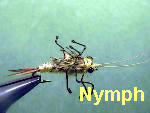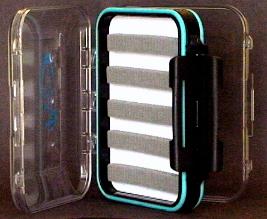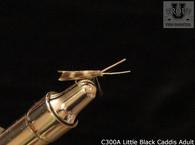Golden Stonefly Nymphs:
Golden Stonefly nymphs crawl on the bottom of the stream searching for food and they aggressively feed on other  smaller insects. They can take as much as two years to mature similar to the hellgrammites. Since they live in strong fast water, they are subject to being caught in the current and washed away, especially the younger nymphs less than two years old.
smaller insects. They can take as much as two years to mature similar to the hellgrammites. Since they live in strong fast water, they are subject to being caught in the current and washed away, especially the younger nymphs less than two years old.
The golden stonefly nymphs range in color from dark brown to a light golden tan and like all other stoneflies, they crawl out onto the banks to hatch. This path to the banks makes them vulnerable to the trout that enjoy feeding on them. Sometimes, however, they will hatch on a log or a rock that projects above the surface of the water. As they make their way to the banks, they move into slower runs, the shallower pockets of water providing ample opportunity for the trout to feed on them.
Your approach should be the same as with all stonefly nymphs, along the banks being careful not to spook them. Remember the trout can hear you by using their lateral line to pick up the sound of you walking. You can use a golden stonefly nymph anytime during the year even when they are not hatching. If doing so, you will increase your odds, by using a smaller nymph imitation which can also be seen by the trout as some other smaller species of stoneflies in the water at the same time.
Golden Stonefly Nymph Presentation:
The golden stonefly nymphs begin to hatch very late in the day so you should start using the nymph no sooner that the mid afternoon. You are trying to imitate the adult stonefly’s behavior as they migrate toward the shore
Avoid walking down through the water preferring to ambush the trout from the banks so as not to spook the trout. As you may already know, the trout can hear you through their lateral line as you walk on the bank. So stay close to the water but be very careful with your approach. Cast the fly out into the runs and riffles using a down and across cast allowing the fly to swing from the runs and riffles all the way to the bank. Pick up the rod tip frequently and let it drop so the fly will move a few inches with each movement.
Again, if you are unable to stay on the bank due to obstacles, wade into the water carefully and make a reach cast, reaching out towards the center of the stream, and then slowly swinging the fly across to the opposite side all the way to the bank. Adjust your weight as necessary to maintain the fly along the bottom where the trout will be feeding. Fish the runs and the riffles and consider using the high sticking style or the Czech nymphing style of fishing.
Be sure that there are some pockets of moderate or slow moving water near the banks, where you are fishing, if not move on.
 smaller insects. They can take as much as two years to mature similar to the hellgrammites. Since they live in strong fast water, they are subject to being caught in the current and washed away, especially the younger nymphs less than two years old.
smaller insects. They can take as much as two years to mature similar to the hellgrammites. Since they live in strong fast water, they are subject to being caught in the current and washed away, especially the younger nymphs less than two years old. 





